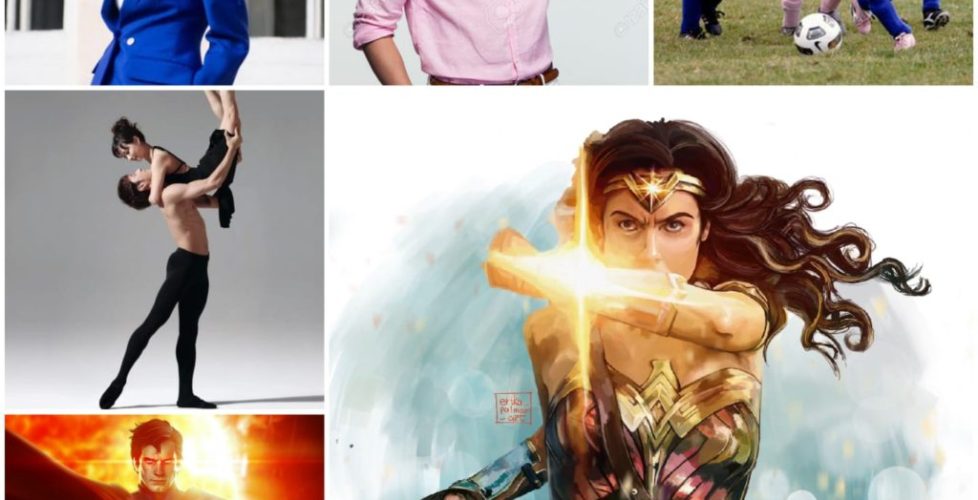Kathryn Tse-Durham: Boys and Girls, What Will Your Verse Be?
Recently, my boy turned five years old. Amidst the pandemic, we still managed to have a sweet and quiet celebration. It was a tranquil Monday afternoon, and I took him to the beach for lunch with our lovely helper and handsome corgi and had the best time. There was hardly anybody about. We were wandering around when we came upon a colourful store selling various party paraphernalia. Elated, I decided to get him one of those gigantic helium foil balloons for his birthday, and like any five-year-old with a penchant for big floating objects, he jumped at the idea. The shopkeeper was very friendly and enthusiastically presented us with several colour options for the “5” balloon. My son, who is currently obsessed with trains and Paw Patrol and Marvel and DC superheroes, adamantly proclaimed, “I want pink!” I laughed and asked him if he was sure, since he normally chooses blue, supposedly his favourite colour. Then the well-meaning shopkeeper commented, “Well, if he chooses pink, we can make it look less girly by pairing it up with a Superman balloon! What do you say?”
My boy thought it was an ingenious idea – after all, he wouldn’t forego the opportunity to get two huge balloons, and better yet, he could get more Superman paraphernalia! But as I was paying at the counter, something nagged at me. Why did the woman feel that we had to dilute the pink with something ‘masculine’? Why is it considered undesirable for a boy to choose pink, but perfectly OK for a girl to choose blue or green or black or grey? And it occurred to me that from a very young age, boys, including my son, are socialized and conditioned, either subtly or blatantly on a daily basis, to believe that they should steer clear of feminine things because boys should like boy things, and if you don’t you might get teased or even beaten up. But therein lies the double-standard – why are girls not encouraged to the same degree to steer clear of boyish or masculine things?
I grew up reading books about girls (who remembers The Baby-Sitters Club and The Sweet Valley Twins? Oh, the nostalgia!) and boy protagonists (The Lord of the Rings and Harry Potter kept me up on nights I should’ve been studying). As a teen, I preferred wearing ripped jeans and cargo pants and baggy sweaters, and I hated pink and loved wearing black. Nobody berated me outright, though I think my mother secretly thought I should’ve worn dresses more.
Before J.K. Rowling became a household name, Bloomsbury asked her to go with her initials instead of her first name, Joanne, because they anticipated that boys wouldn’t be as inclined to read books written by a woman. Rowling accepted this, wanting to go along with the big guns as she was young and poor and unknown. And when her books went on to become phenomenally successful, garnering millions of readers around the world of all genders and ages and backgrounds, and Rowling became the richest author in the world, the fact that she is female became a moot point. I have never known any parent to discourage their daughter from reading Harry Potter because it’s about a boy protagonist. But I have known parents who discouraged their sons from reading books about female protagonists.
When I pursued my dream of getting published, I decided to write a story about a heroine named Ellanor, a preteen who would just be as dynamic and interesting as other boy protagonists, if not more so. And I wanted boys and men to read it and enjoy it, too (which has happened!). And when I got signed by Hedgehog Publishing, I decided to go from K.T. Durham to my full name, Kathryn Tse-Durham, so that boys would know that not only am I a female writer and proud of it, but I am also of Chinese descent, of which I am proud, too.
A few months ago, I read an excellent and thought-provoking article written by American author Caroline Paul titled ‘Why Boys Should Read Girl Books’. Paul talks about how a middle school declined her offer to speak to their students about her latest book, The Gutsy Girl: Escapades for Your Life of Epic Adventure, because the school reasoned that such a book would exclude boys. Paul was shocked and confused. Her book may not be about a boy protagonist, but that doesn’t mean boys are excluded. It just means that the book isn’t about them. This is America, supposedly the most progressive and open-minded nation in the world. In such developed societies, archaic views still persist, and are perpetuated, by those who appear to champion values like equality and inclusion. Paul then wrote about another writer who had written a book that featured girls, and when she attended a school assembly to speak to the students, she saw that many of the seats were vacant because the boys, it turned out, had been excused from the program.
Back in 2016 when Paul wrote her article, she took a look at the New York Times children’s bestseller list. At first glance, the books seemed to vary wildly. There were stories about magical cats, robots, and prepubescent heroes. But that week, and for weeks after, Paul found that of the top ten, nine featured Caucasian boys. Not a single bestseller had a sole female protagonist. Paul came to conclude that many authors and publishers are throwing their weight behind certain books because of this widespread, and ultimately damaging, belief that everyone will and should read about boys, but not about girls. So what does this mean?
In the timeless and wonderful film Dead Poets Society, Robin Williams’ character Mr John Keating, a charismatic and passionate teacher of English literature, says this in one of the most moving scenes ever: “No matter what anybody tells you, words and ideas can change the world. We don’t read and write poetry because it’s cute. We read and write poetry because we are members of the human race. And the human race is filled with passion. Medicine, law, business, engineering – these are all noble pursuits, and necessary to sustain life. But poetry, beauty, romance, love – these are what we stay alive for. That you are here, that life exists. And identity. That the powerful play goes on, and you may contribute a verse. What will your verse be?”
His words will always stay with me, not least because they were voiced by one of my favourite actors who died too soon. We all play a part in the scheme of things. What will my verse be? What will your verse be in the way that boys and girls are raised, in the way that the world is being shaped and transformed?
You see, we read to experience a myriad of perspectives. We read to learn about people and situations outside and beyond ourselves, so we can deepen our connection and understanding of the human experience. Because we are all different, and every person is unique, and it’s important that we respect our differences as well as celebrate the fundamental similarities that make us all human. We can learn to disagree with each other and still be friends. We read, and write, to prepare for life. So think about it: if we discourage boys from reading about girls and women, aren’t we raising our boys to dismiss other people’s experiences, and to believe that their needs and concerns are the centre of the universe? By encouraging them to dismiss stories about girls and women, as well as other community groups, in essence aren’t we raising our boys to lack empathy? The agreement that boys shouldn’t read about girls, that in fact it’s shameful to be interested in what girls do and think about in books, is an unspoken agreement that can ultimately lead to things like misogyny and abuse and mistreatment of girls and women. Look at how the media convinces boys that anything considered remotely girl-like is to be avoided, even reviled. When a boy is directed to books that reflect only a narrow aspect of the world, or he is shamed for any interest in what is considered a “girl book,” his understanding of girls and therefore of himself is awfully fragmented and skewed.
I write The Ellanor Chronicles to entertain and to inspire joy and hope and values of love and friendship and inclusion. I also write the story to inspire courage and resilience in girls, and to show that girls can be just as cool and interesting and dynamic as boys. In some ways, it is also my way of protesting against the lame stereotypes many boys and men, and even some girls and women, hold of us. It’s high time that everyone sees that girls and women are as much doers as the boys and men. It’s high time that boys aren’t shamed for reading girl books, for everyone’s sake. On the bright side, some things are slowly improving. Today, I checked out the New York Times children’s bestseller list, and I’m somewhat encouraged to see that three out of the top ten feature girl protagonists. But there is still a fair way to go.
As a mother to a young boy, I believe it is my duty to raise him to appreciate the differences and similarities between people, and to respect both men and women of all skin colours and backgrounds and walks of life. And now that my daughter will soon be born (I’m balancing my Macbook on my massive belly as I write this), I want the same for her. I want my children to become dynamic people who can be strong yet nurturing, gentle yet firm, assertive yet understanding, adventurous yet wise. I want them to see that both mummy and daddy can team up and cook and clean and earn the bread and butter, and both can sing lullabies and change the dirty nappies. I want them to know that it’s OK for boys and girls to both like pink and simultaneously love superheroes like Superman and Captain America and Wonder Woman. I want them to know that both men and women can rescue each other and hold each other up, just as Ellanor carries Aron to safety when he is injured, and she berates him for thinking he shouldn’t be saved by a girl (as seen in my new book Ellanor and the Land of the Midnight Sun). Boys can enjoy girl books like The Ellanor Chronicles and love Iron Man and video games and football; and girls can enjoy Harry Potter and Percy Jackson and like wearing dresses and make-up and do ballet or weight-training. Because life, and people, exists on a broad and beautiful spectrum. We don’t all fit neatly into boxes. Otherwise, it would be an awfully dull world, don’t you think?
Kathryn Tse-Durham
Author of The Ellanor Chronicles
21st January 2021
This blog post is also posted on Kathryn’s Facebook Page. Visit here.

